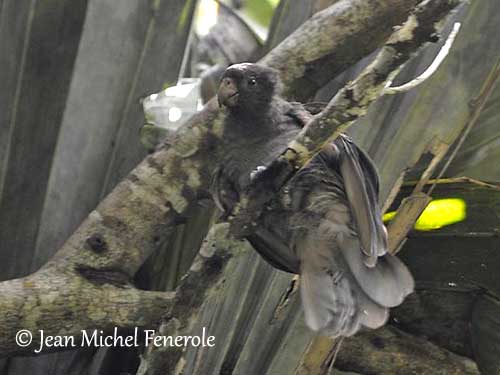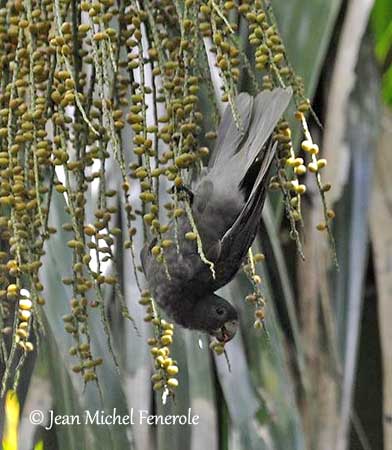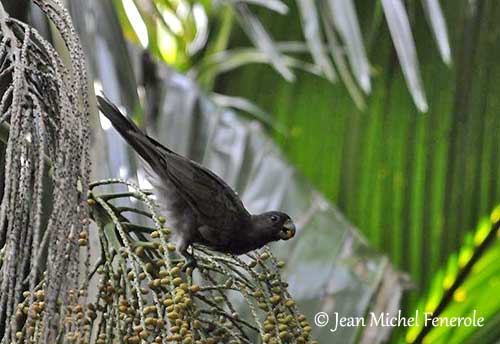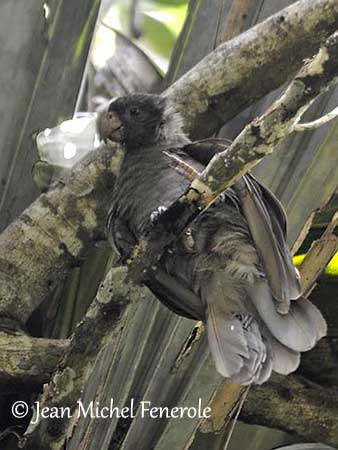
Fr: Vasa des Seychelles or Vaza des Seychelles
Ang: Seychelles Black Parrot
All: Seychellenpapagei
Esp: Loro de Seychelles
Nd: Praslinpapegaai
Sd: seychellvasapapegoja
Photographer:
Jean Michel Fenerole
Photos d’Oiseaux du monde
Text by Nicole Bouglouan
Sources :
HANDBOOK OF THE BIRDS OF THE WORLD vol 4 by Josep del Hoyo-Andrew Elliott-Jordi Sargatal - Lynx Edicions - ISBN: 8487334229
PARROTS OF THE WORLD – An Identification Guide – by Joseph M. Forshaw – Princeton University Press – ISBN 0691092516
Wikipedia, the free encyclopaedia
Seychelles black parrot declared endemic bird species by BirdLife International experts
Count your chicks! Endemic Seychelles Black Parrot hatchlings bring hope for vulnerable species
Breeding ecology of the Seychelles Black Parrot Coracopsis barklyi
Breeding Biology of the Seychelles Black Parrot (Coracopsis nigra barklyi)
AQUA-FIRMA – Water – Wilderness- Wildlife
CITY PARROTS – Urban parrot conservation
Insights into the feeding ecology of the Seychelles Black Parrot Coracopsis barklyi using two monitoring approaches [2014]
Seychelles Black Parrot monitoring programme starts again
Seychelles Black Parrot
Coracopsis barklyi
Psittaciformes Order – Psittaculidae Family
INTRODUCTION:
The Seychelles Black Parrot is now a full species endemic to the Seychelles Islands. It was formerly a subspecies of Coracopsis nigra or Black Parrot, native from Madagascar. Parrots of genus Coracopsis are found only in the Western Indian Ocean.
This species has restricted range. Its decline throughout the 20th century was due to predation by introduced mammals, hunting and pet trade. The species is currently listed as Vulnerable, but its recognition as a full species will involve more efforts to ensure the conservation of the national bird of Seychelles.
DECRIPTION OF THE BIRD:
Biometrics:
Length: 35-40 cm
Weight: 132-153 g
The Seychelles Black Parrot adult has dark, greyish-brown plumage overall, including the head where some pale brown streaks are inconspicuous on the crown. The uppertail-coverts are slightly paler. On the wing, there is some grey-blue reflection on the outer webs of the primary feathers.
The underparts are pale greyish-brown. We can see some short-buff streaks on the throat, whereas breast and belly show indistinct pale barring. The undertail is pale grey.
The dark grey bill becomes paler during the breeding season. The cere is yellowish. The eyes are dark brown, surrounded by bare, grey eyering. Legs and feet are dark grey to bluish grey.
Male and female are similar.
The immature has some yellowish tinge around the bill, and an ochraceous tinge on face, throat and upperbreast. Undertail-coverts are pale with pale grey tips to rectrices.

RANGE:
The Seychelles Black Parrot is found on Praslin Island in the Seychelles. It also occurs on Curieuse Island, but currently, no breeding is recorded on this island.
HABITAT:
The Seychelles Black Parrot breeds in mature palm forest in Vallée de Mai Nature Reserve in the National Park of Praslin. It is usually found in woodland, scrubland and gardens. It frequents mixed forests with palms and other introduced species. It can be seen on coastal beach crests with endemic trees, but also in hotel gardens and cultivated areas.
CALLS AND SONGS: SOUNDS BY XENO-CANTO
The Seychelles Black Parrot is sometimes very vocal during the day and on moonlit nights. Its calls become more frequent at the beginning of the breeding season, and when they form large flocks. It calls from perch or in flight.
It utters flute-like whistles, becoming more melodious when breeding “wee-too-twee…wee-too-twee”. It gives some shrieking, discordant calls “kreeer kreer kreeer” and low-pitched, sharp “kek… kek”. It is often heard before seen!
BEHAVIOUR IN THE WILD:
The Seychelles Black Parrot feeds on fruits and seeds of numerous plant species, and especially endemic and native species. It feeds mainly on fruit pulp, buds and seeds. It may take occasionally flowers, leaves, bark and scale insects, and cultivated fruits such as papaya, mango and guava.
It feeds mainly in early morning and late afternoon, usually at mid-level in forest and occasionally on the ground.

The Seychelles Black Parrot is wary but not shy. If disturbed, it climbs slowly to reach a more concealed place among the vegetation. However, it can be seen perched conspicuously at top of dead tree.
The Seychelles Black Parrot nests in cavities in palm trees, usually Lodoicea maldivica. They are monogamous like most Psittacidae.
Information about the courtship displays is currently lacking, but we can suggest that this species uses the typical behaviour involving head-bobbing and head-stretching, tail-fanning and bill-contact with a food-pass.
However, these parrots practice an unusual side-by-side copulation with mates sitting next to each other. The cloacal mass or hemi-penis of the male enters that of the female, resulting in a remarkable protracted copulation, with both mates locked together for more than one hour.
The pair-bond is maintained and strengthened by mutual preening.
The Seychelles Black Parrot is resident within its range and only performs movements between the roosting sites in highlands and the feeding areas in lowlands. These birds fly regularly between Praslin and Curieuse (1 km).
The Seychelles Black Parrot has graceful flight with strong, steady wingbeats interspersed with long glides.

REPRODUCTION OF THIS SPECIES:
The breeding season starts in September/October, with the laying in November/December. The Seychelles Black Parrot produces a single brood per season.
It nests in tree holes, usually in palms but also in Albizia. The nest-cavity is usually placed between 3 and 9 metres above the ground. It is fairly deep, with a diameter of 23-26 centimetres. These parrots also use nest-boxes when suitable nesting sites are destroyed.
The female lays 1-3 white eggs and incubates alone during 14-18 days. At hatching, the chicks are covered with white down. They fledge between 35 and 60 days after hatching, but they still depend on parents for several months after fledging. Generally, only two chicks are reared, the third one usually dies.
Nest predation by introduced rats is probably the main cause of nest failure. However, the use of rat-proof nest-boxes allows higher breeding success.
PROTECTION / THREATS / STATUS:
The Seychelles Black Parrot has restricted range and small population. This species is affected by predation at nest by rats, hunting by farmers, pet trade and incidental trapping. They are threatened by diseases such as Psittacine Beak and Feather Disease and competition for food and nest-sites from introduced species such as the Common Myna and the Rose-ringed Parakeet. Habitat loss, mainly suitable trees for nesting, persecution and pesticides are other serious threats.
The population is estimated to number 340/600 mature individuals, equating to 520/900 individuals. This population appears currently stable.
The Seychelles Black Parrot has been officially recognized as a distinct species, and this new status will provide much support for the local conservation works.
The Seychelles Black Parrot is currently listed as Vulnerable.
